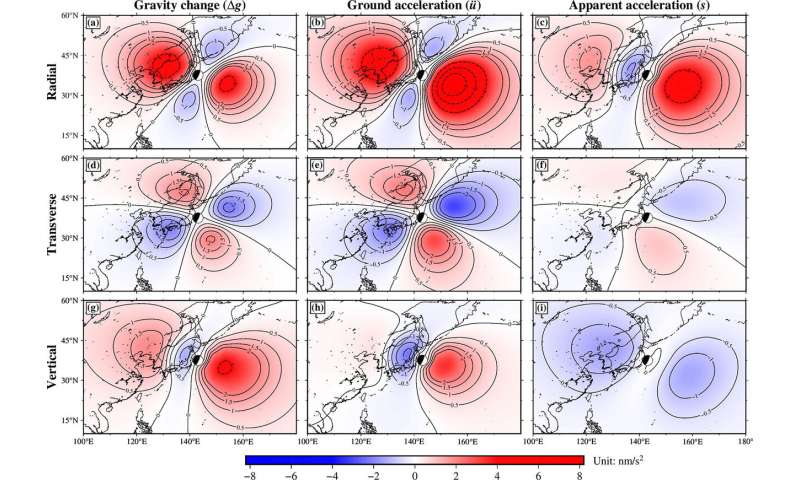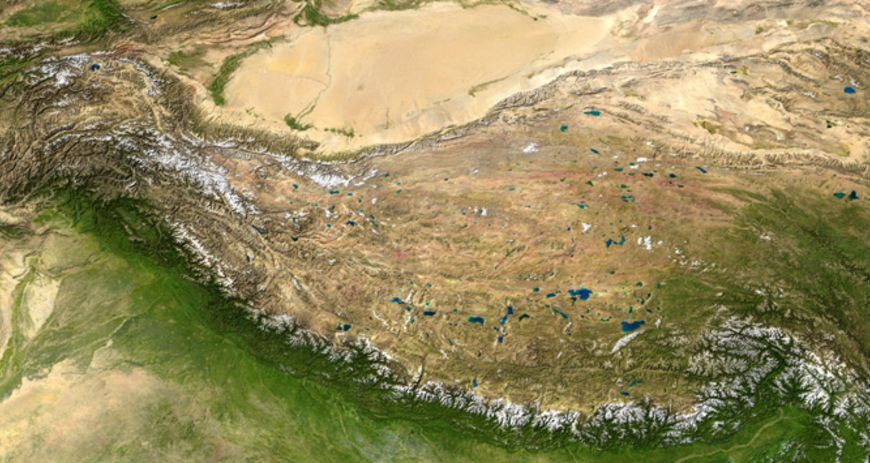From Helmholtz Association of German Research Centres

Spatial distribution of PEGS (PEGS = prompt elasto-gravity signals) signal strength during the Tohoku quake in 2011, shortly before the arrival of the primary seismic wave. Credit: Earth and Planetary Science Letters, Vol 536, Zhang et al. 2020 [below], “Prompt elasto-gravity signals (PEGS) and their potential use in modern seismology”,sciencedirect.com/journal/earth-and-planetary-science-letters, with permission from Elsevier.
Lightning—one, two, three—and thunder. For centuries, people have estimated the distance of a thunderstorm from the time between lightning and thunder. The greater the time gap between the two signals, the further away the observer is from the location of the lightning. This is because lightning propagates at the speed of light with almost no time delay, while thunder propagates at the much slower speed of sound of around 340 metres per second.
Earthquakes also send out signals that propagate at the speed of light (300,000 kilometers per second) and can be recorded long before the relatively slow seismic waves (about 8 kilometers per second). However, the signals that travel at the speed of light are not lightning bolts, but sudden changes in gravity caused by a shift in the earth’s internal mass. Only recently, these so-called PEGS signals (PEGS = prompt elasto-gravity signals) were detected by seismic measurements. With the help of these signals, it might be possible to detect an earthquake very early before the arrival of the destructive earthquake or tsunami waves.
However, the gravitational effect of this phenomenon is very small. It amounts to less than one billionth of the earth’s gravity. Therefore, PEGS signals could only be recorded for the strongest earthquakes. In addition, the process of their generation is complex: they are not only generated directly at the source of the earthquake, but also continuously as the earthquake waves propagate through the earth’s interior.
Until now, there has been no direct and exact method to reliably simulate the generation of PEGS signals in the computer. The algorithm now proposed by the GFZ researchers around Rongjiang Wang can calculate PEGS signals with high accuracy and without much effort for the first time. The researchers were also able to show that the signals allow conclusions to be drawn about the strength, duration and mechanism of very large earthquakes. The study was published in the journal Earth and Planetary Science Letters.
An earthquake shifts the rock slabs in the earth’s interior abruptly, and thus changes the mass distribution in the earth. In strong earthquakes, this displacement can amount to several meters. “Since the gravity that can be measured locally depends on the mass distribution in the vicinity of the measuring point, every earthquake generates a small but immediate change in gravity,” says Rongjiang Wang, scientific coordinator of the new study.
However, every earthquake also generates waves in the earth itself, which in turn change the density of the rocks and thus the gravitation a little bit for a short time—the earth’s gravity oscillates to some extent in sync with the earthquake. Furthermore, this oscillating gravity produces a short-term force effect on the rock, which in turn triggers secondary seismic waves. Some of these gravitationally triggered secondary seismic waves can be observed even before the arrival of the primary seismic waves.
“We faced the problem of integrating these multiple interactions to make more accurate estimates and predictions about the strength of the signals,” says Torsten Dahm, head of the section Physics of Earthquakes and Volcanoes at GFZ. “Rongjiang Wang had the ingenious idea of adapting an algorithm we had developed earlier to the PEGS problem—and succeeded.”
“We first applied our new algorithm to the Tohoku quake off Japan in 2011, which was also the cause of the Fukushima tsunami,” says Sebastian Heimann, program developer and data analyst at GFZ. “There, measurements on the strength of the PEGS signal were already available. The consistency was perfect. This gave us certainty for the prediction of other earthquakes and the potential of the signals for new applications.”
In the future, by evaluating the changes in gravity many hundreds of kilometres away from the epicentre of an earthquake off the coast, this method could be used to determine, even during the earthquake itself, whether a strong earthquake is involved that could trigger a tsunami, according to the researchers. “However, there is still a long way to go,” says Rongjiang Wang. “Today’s measuring instruments are not yet sensitive enough, and the environmentally induced interference signals are too great for the PEGS signals to be directly integrated into a functioning tsunami early warning system.”
Plate tectonics

A crash in super slow motion

Image: NASA
The severe earthquake in Nepal at the end of April shifted the earth’s surface by several metres at many locations. These powerful forces arise from the convergence of two continental plates – and have been recurring for 50 million years.
A human lifespan in relation to the history of our planet is as short as the blink of an eye. This is the reason that it is so difficult for us to perceive changes that drag on over millions of years. Mountain ranges appear to us to be static and scarcely changeable. They were, however, created in a dynamic process – as a result of a collision between two tectonic plates. In the case of the Himalayas, this process has been continuing until this day. About 50 million years ago, the Indian and the Eurasian continental plates collided. Ever since this convergence, they have pushed into one another to a distance of around 2,000 to 3,000 kilometres with a velocity of five centimetres per year. The geologists speak of convergence here. And these plates are still doing it – at the same speed. Prior to the collision, they were moving towards one another at a speed of more than ten centimetres per year. This motion of slowly sliding into each other can be felt in the form of frequently occurring earthquakes, in which the built-up tension is released.
“Four to five centimetres per year are actually quite fast for the movements on earth,” explains Lothar Ratschbacher from the Technische Universität Bergakademie Freiberg. He says that it is unusual that it is still continuing. Other convergences between continental plates have come to a standstill much quicker. For example, in the case of the African and European tectonic plates this caused the emergence of the Alps, among other things. Exactly why this collision between the Indian and Eurasian plates represents an exception is being actively discussed in the scientific arena, says Bernd Schurr from the Helmholtz Centre Potsdam – GFZ German Research Centre for Geosciences. There are three models which clarify the phenomenon. One is based on the premise that the Indian plate – a thick plate today – originally had an approximately 1000 kilometre long, thin continental margin. This margin was in fact thinner, but on the basis of its composition heavier than the edge of the Eurasian plate, and therefore pushed itself down underneath it: “It could have the force to continue pulling the Indian plate into the Eurasian plate,” explains Schurr, who conducts research on tectonics and the geodynamic processes in mountain ranges.
In a second model, the scientific community assumes the existence of huge, so-called convection cells within the earth’s mantle. It is a principle that is similar to what happens inside a cooking pot: cold material sinks because it is heavier than warm material – it is then heated and rises again and so on. Cells can thus form in which, on one side, cold material sinks and, on the other side, warm material rises. These convection zones could continue to force the plates upward from underneath, and continue to push, like on an assembly line, the Indian plate into the Eurasian plate. In the third model the possibility is also being discussed that the Indian and Australian plates are somehow interconnected. Because the heavy Australian plate is submerging underneath Southeast Asia, it could possibly pull the Indian plate downwards.
Nepal and also the Himalayan Mountains appeared as a consequence of the convergence between the Indian and Eurasian plate, as a crumple zone, so to speak. “Usually, the plate that is pushing underneath – the Indian, in this case – is shortened, and that’s where most of the mountain range is formed. Regarding the Himalayas, we have deduced that the plate has been shortened by between 700 and 1000 kilometres since the collision,” says Lothar Ratschbacher, tectonic physics instructor in Freiberg. That is less than the length that the two plates have pushed into each other overall. This is because it is not only the Himalayas that have reacted to the pressure over the course of millions of years: “The formation of mountains occurs outwards, and in the case of the Indian-Asian collision zone, this means to the south and to the north.” In other words, Tibet and other ranges, for example the Tian Shan, folded and are still folding.
But of course, this folding process in the earth’s surface certainly did not (and still does not) go unnoticed, Lothar Ratschbacher clarifies: “All deformation in the upper 10 to 30 kilometres of the earth’s crust occurs due to earthquakes. This is due to the fact that the low temperatures prevailing there only allow brittle deformity of the rock.” This is why the earth in Nepal quaked, and in the Himalayas the rock pushed either up or down at some locations. Underneath the Himalayas and Tibet, temperatures of 1000 degrees Celsius occur in the crust, which is up to 70 or 80 kilometres thick. This is the reason that no fracture occurs there – and thus no earthquakes occur either.
Large earthquakes, like the one in Nepal in April, must have occurred countless times in the course of the last 50 million years. Bernd Schnurr is hesitant to make a speculation on when the collision between the two plates will come to a standstill. But it is certain that at some point – in the course of many millions of years – the time will come when the earth in this region no longer buckles. “The force of gravity in the stacked-up mountain ranges works in severe opposition to the driving forces behind the plates,” he says.
See the full article here .
